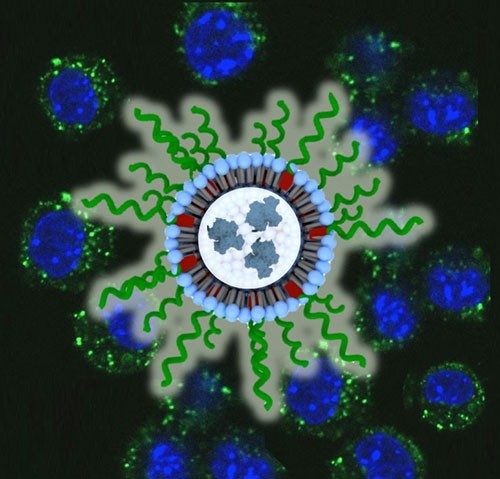FOR IMMEDIATE RELEASE | August 17, 2020
Immunotherapy extends survival in mouse model of hard-to-treat breast cancer (video)
Note to journalists: Please report that this research will be presented at a meeting of the American Chemical Society.
A press conference on this topic will be held Monday, Aug. 17, at 10 a.m. Eastern time online at http://www.acs.org/fall2020pressconferences.
WASHINGTON, Aug. 17, 2020 — Immunotherapies for cancer — treatments that prime the immune system to attack tumors — are valuable weapons in the anti-cancer arsenal. But some cancers are more difficult to target with this strategy than others. Today, scientists report a new type of immunotherapy that dramatically extends the survival of mice that have triple negative breast tumors, a difficult-to-treat form of cancer.
The researchers will present their results at the American Chemical Society (ACS) Fall 2020 Virtual Meeting & Expo. ACS is holding the meeting through Thursday. It features more than 6,000 presentations on a wide range of science topics.
A brand-new video on the research is available at www.acs.org/fall2020-breast-cancer.
“From an immunotherapy standpoint, one of the biggest problems with triple negative breast cancer is that it doesn’t produce any known antigens, or molecules recognized by the immune system, that are unique to the tumor,” says Cassandra Callmann, Ph.D., who is presenting the work. “If you don’t have a known tumor-specific antigen, it’s hard to train your immune system to go after the tumor while ignoring healthy cells.”
According to the Triple Negative Breast Cancer Foundation, this disease accounts for 15–20% of all breast cancers. The tumor gets its name from the fact that it tests negative for the estrogen receptor, the progesterone receptor and excess HER2 protein — three proteins commonly produced in large amounts by other types of breast cancer. Because triple negative breast cancer lacks these markers, many commonly used breast cancer drugs aren’t effective. This is one reason triple negative breast cancer has a poorer prognosis than other forms of the disease, according to the American Cancer Society.
To develop a new type of treatment, Callmann, a postdoctoral fellow in the lab of Chad Mirkin, Ph.D., at Northwestern University, needed to take a different approach from conventional immunotherapies that target a tumor-specific antigen. “The idea was to take tumor cells, chop them up, feed them to the immune system and let it figure out what to go after on its own,” Callmann says. Other researchers have tried this approach for different cancers, but they typically administer both the chopped-up tumor cells (called a lysate) and a molecule that stimulates the immune system, known as an adjuvant, as a mixture. Instead, the team packaged the lysate and the adjuvant together in a single nanoparticle. The nanoparticle, called a spherical nucleic acid (SNA), contained the lysate inside its core and many copies of a DNA adjuvant radiating from its lipid membrane shell.
When the team injected SNAs under the skin of mice, the SNAs traveled to the lymph nodes. There, SNAs entered the cells, released their cargo and stimulated the cells to mount an immune response against antigens in the lysate. Interestingly, a stronger immune response occurred when the researchers incorporated oxidized tumor cell lysates from stressed tumor cells into SNAs.
The researchers tested the treatment on mice in which mouse triple negative breast cancer tumors were implanted. Two-thirds of mice receiving SNAs with oxidized lysates experienced complete tumor remission for at least 90 days, whereas all untreated animals died by day 30. None of the treated mice had obvious side effects or autoimmune responses.
The therapy is not yet ready for clinical trials, Callmann says. One of the next steps will be to investigate why the oxidized lysates work better than regular lysates. The team has begun to identify subsets of the lysates that are more immunogenic than others. She notes that a stressed cell could be producing different proteins, or perhaps the oxidizing agent is changing chemical groups on proteins. To get a clearer picture, Callmann plans to conduct a proteomic analysis to identify proteins that differ between oxidized and non-oxidized lysates.
The oxidized lysate/SNA approach might prove useful for treating other tumors, as well. “We have demonstrated that the overall structural presentation of a cancer vaccine or immunotherapeutic, as opposed to simply the identity of the active chemical components, dictates its potency, and this finding is opening doors in the field,” Mirkin says.
The researchers acknowledge funding from the Lefkofsky Family Foundation, the American Committee for the Weizmann Institute of Science, the International Institute for Nanotechnology at Northwestern University and the National Cancer Institute.
The American Chemical Society (ACS) is a nonprofit organization chartered by the U.S. Congress. ACS’ mission is to advance the broader chemistry enterprise and its practitioners for the benefit of Earth and its people. The Society is a global leader in providing access to chemistry-related information and research through its multiple research solutions, peer-reviewed journals, scientific conferences, eBooks and weekly news periodical Chemical & Engineering News. ACS journals are among the most cited, most trusted and most read within the scientific literature; however, ACS itself does not conduct chemical research. As a specialist in scientific information solutions (including SciFinder® and STN®), its CAS division powers global research, discovery and innovation. ACS’ main offices are in Washington, D.C., and Columbus, Ohio.
Media Contact
ACS Newsroom
newsroom@acs.org
View Larger Image






